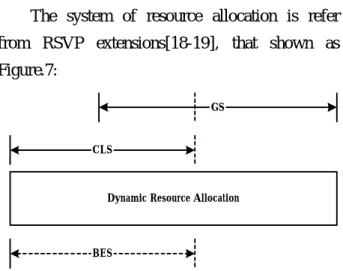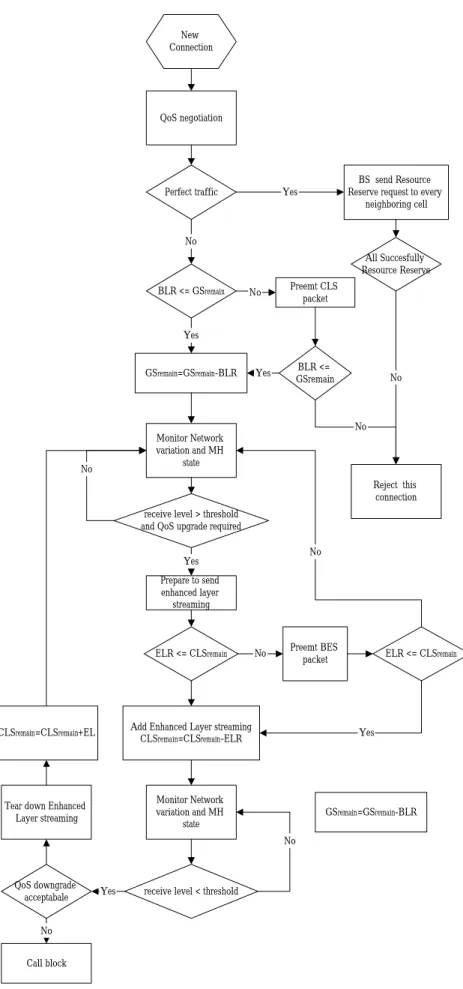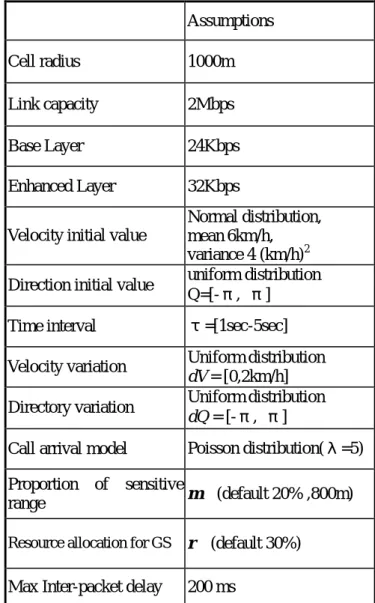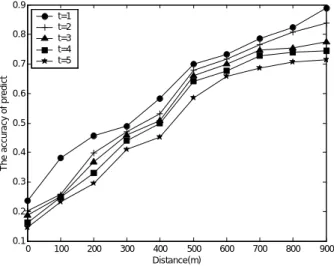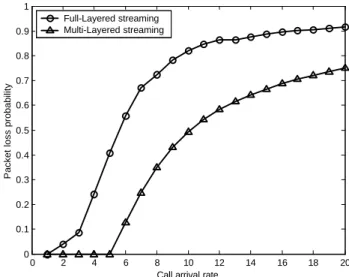A Soft Resource Reservation Scheme for Layered Video During Handoff on The 3G Wireless Networks
全文
(2) higher transmission capability, macro-cell adopts. demand of multi-media play, we reduce greatly the. high frequency with low power rate. As to the. problem of over low rate for the use of resource. smaller scope of Micro-cell or Pico-cell mode, the. caused by surplus reservation.. occurrence of handoff becomes more frequent. Multi-media. video. has. featured. To cope with the influence resulting from the with. change of network transmission rate, a mechanism. continuance, so over long delay or interruption will. of scalable video coding for solution has been. be affected greatly to the quality of play for the. raised. Refer to Figure. 2, original video data can. user. In order to let multi-media video can be. be encoded into multi-stream. Among it, a basic. played continuously, many researchers raise the. -stream can be decoded into rough image. While,. mechanism of reservation [8-11]. When MH user. other sub-streams can be applied for enhancement.. requests for multi-media, the process of reservation. Although Enhancement layer streaming is unable. will function around cells. Thus, the better QoS can. to play from encoding alone, the quality of image. be provided at handoff and keeps lower connection. can be upgraded after combination with base layer. dropping probability.. streaming [7,12]. Through encoding of multi-media. The Figure 1 indicates that when MH at Cell A, the advanced resource will be reserved for Cell 1,2,B,6,7,8. When MH at Cell A Handoff to Cell B,. video streaming, the traffic type can be set according to the requirement of the users and the present condition of network.. the process of reservation will be changed to Cell. In this paper, the proposed scheme includes. 2,3,4,5,6,A nearby Cell B. As to the Cell 1,7,8, for. call admission and specific reservation to guarantee. not nearby Cell of MH, the original reservation. QoS requirements. When MH has reached the. resource is released simultaneously at completion. overlap scope between two cells, neural network. of Handoff.. will estimate the possibility to enter into target cell to active for reserved resource. Through this initial action, the improper reservation resource resulting in low rate of use nearby cell can be avoided, and MH unable to get resource required resulting in interruption of multi-media play at handoff could be reduced. The important points of this paper are. Fig.1 When MH moves, the change of reservation. specified below. In the second section is to introduce the various methods to process for. for resource. resource reservation in the wireless network. In the Volume of reservation and rate of use is a matter of tradeoff, and the resource of wireless network is limited. When MH stays continuously at the same location and no action for handoff, the resource. for. reservation. becomes. a. waste.. Therefore, we present Soft Resource Reservation Scheme in this study. In addition to meet the. third section is to describe the frame of system for proceeding, including introduction of environment, operation flow, and solution points. In the fourth section is the result of this simulate laboratory, and the conclusion of this study is listed in the fifth section..
(3) Base layer compressed streaming Raw Video. Base layer compression. Base layer decompression. Enhancement layer compression. Enhancement layer compressed streaming. +. (a) Sender. Base layer compressed streaming. Base layer decompression. Enhancement layer compressed streaming. Enhancement layer decompression. Base layer decoded video. Enhancement layer decoded video. +. (b) Receiver. Fig. 2 Layered encoding and decoding video 2. Resource reservation In the transitional period of handoff, using the resource reservation and high-speed state of resource allocation can reduce the dropping probability of handoff call. On 3G wireless multi-media network, in order to increase the capacity, cell is changed for a smaller frame to increase greatly the channel reuse and data. D. A. Levine et al. raised the concept of Shadow Cluster [9]. Cell will exchange MH location and movement pattern, etc. information for nearby cells after every period of time to predict handoff. probability. for. MH. and. reduce. unnecessary reserved waste. But, this scheme shall be resulted in large overhead of BS for huge information exchange volume between cells.. transmission rate. However, this causes the handoff. G.S. Kuo et al. raised one Semi-Reservation. frequency increased greatly at different cells for. Scheme [10] to set 100% for total rate of nearby. wireless user.. cells moved from MH. In other words, when a. Carlos Oliverira et al. [8] raised Adaptive Bandwidth Reservation Scheme. When MH user requests for multi-media, the reservation of bandwidth nearby cell is proceeded. Meantime, through continuous monitor dropping probability, the size of reserved bandwidth pool can be changed. Although the better QoS is provided at handoff and. certain cell of MH has higher handoff probability and simultaneously low down handoff probability for other cells, the total value is still fixed at 100%. Basically, this assumption is no problem. But, when MH still stays at fixed location without Handoff, then reserved resource is unavoidable to be a waste.. keeps lower connection dropping probability, the. If the reserved resource in the cell can expert. required bandwidth for multi-media video is quite. the effectiveness, it depends on whether MH will. large. If resource reserved simultaneously for. enter into that cell. Therefore, if the movement. nearby cell, then idle reservation will be created. pattern of MH can be held, then it helps to upgrade. easily resulting in over large probability for new. the effect for resource reserved and also increase. call blocking and low rate of use for bandwidth.. the use rate of resource. Many researchers who use MH historical movement pattern predict entering into the cell and the occurrence of handoff..
(4) However, the models from data analysis and. prohibited. Specially, under the circumstance of. statistical record, they are most suitable for big cell.. increasing requirement on multi-media day by day,. Because in the small cell with shorter scope of. improper system reservation results in less system. function for wireless signal, the occurrence. capacity and creates more negative influence to. frequency of handoff become higher resulting in a. QoS. While, Back Propagation Neural Networks. similar random situation for the wireless user.. can go through supervision-type of learning to. Therefore, the profiles of any user will become. proceed the training with current existing value of. ineffectiveness.. MH and information of target cell. Therefore, when. However, ordinary MH will not change greatly the direction or speed of movement, so the current location, movement speed, and movement. system proceeds for a new set of information, the probability for entering into a specific cell can be assessed.. direction of MH still can provide some useful information as reference to predict target cell. Under this assumption, Yu et al. [11] constructed a model to describe random situation of movement in the small cell for wireless user. After having obtained the location of coordinates, movement speed and direction of MH, then through Back Propagation Neural Networks, the classification can be proceeded to figure out the possibility for MH to leave current cell and enter into a specific cell. This kind of method is used for initial stage of. Fig. 3. Movement pattern illustration of MH. MH to reserve an estimated resource at nearby cell without exchanging the MH current location for. The important point of this study is to base on. each individual cell so as to reduce greatly the. current technology and modern research, and. overhead consumed for network monitor and. subject to the mechanism of multi-media video. exchange. causes. stream layered encoding to raise dynamic resource. another problem, refer to Fig. 3. From initial call of. allocation, and when MH for movement or facing. MH to entering into cell will spend a certain time,. handoff, basic play quality can be sustained. and during this period, movement direction and. without interruption. The raised mechanism goes. state of speed might be changed. Therefore, it is. through. difficulty to infer target cell correctly for. reservation to judge if MH faced to handoff.. appropriate resource reservation only basing on. Meanwhile, making use of Back Propagation. preliminary information. Meanwhile, the speed. Neural Networks to estimate the correlation on. could affect the time of MH into specific cell, but. possibility for current state of MH and entering into. inappropriate use to predict target cell.. a specific cell to consider about resource. information.. However,. this. active. establishment. for. resource. Bandwidth reservation and use rate of. reservation. When the possibility of neural network. bandwidth is a problem of tradeoff. Under wireless. reaches a certain degree to reserve resource. network environment, the useable resource is. formally, the influence to system caused by idle resource reservation can be eliminated..
(5) 3. System frame design. 3.2 Environment of system. The requirement on multi-media application program is able to satisfy at playing time executed smoothly for the object of multi-media. Because of data capacity of multi-media is usually larger than ordinary file, if loading to Client for temporary save and through player to play, then the user will waste a longer time for waiting and consume big save cost. This problem becomes more seriously for smaller save space on MH. Therefore, using. Under. wireless. network,. the. useable. bandwidth will be descended according to the distance between MH and BS, and increment of interference power rate. Therefore, one method of QoS Guarantee is to have the capability for transmission priority adjustment on lined units (Mobile Host, Base Station, Base Station Controller, Media Sender, and Router, etc.) [15-17]. media streaming lets users save temporarily some. In this study, the wireless network is to. part of information for multi-media at initial stage,. expand the current network service with sender to. and the rest part will be continuously loaded with. MH. There are two sections in the environment of. network at the time of playing. This is the future. wireless network. The Sender to BS adopts current. trend for development.. wired line, service quality is guaranteed with higher speed of Data Transmission Rate. However,. 3.1 BPN-based resource reservation. from BS to MH, the wireless is the actual. Artificial neural networks can be used to. transmission media to transfer data with lower. compute solutions for complex problems. They. transmission rate. Refer to Figure 5 for the. possess an adaptive feature that allows each cell. environment of this system:. within the network to modify its state in response MH has the capability to receive and play. to experience. The neural network can then learn or self-modify. Often, they have been used to mimic expert systems [13]. The Back Propagation Network(BPN)[14] model is a layered feed forward supervised learning network model, first found in P. Werboss dissertation at 1974. BPN provides an effective means of allowing a computer to examine. multi-media data stream. In addition to being a transmitter and receiver, BS also has the capability to know about power rate of MH wireless signal and the hardware condition of MH. Base Station Controller (BSC) is able to manage for wireless resource, calculate different request according to MH movement mode, handoff, and proceeding on. data patterns that are incomplete or noisy.. the arrangement for wireless network packet H1 Θ. P1. Θ. ...... ...... ...... PN. H3 Θ. Y2. T2. YR. TR. Θ. Input Layer N=100. Hidden Layer S=50 training function=trainlm learning function=learngdm transfer function=tansig performance function=mse. Fig. 4. Neural networks system. relative multi-media data streaming according to the requirement of the user [11-12].. Θ. Θ. HS. priority. While, Media Streaming Server has the capability for layered encoding and can provide. Θ. H2 P2. Y1. T1. Output Layer R=10 training function=trainlm learning function=learngdm transfer function=tansig performance function=mse. The transmission step of multi-media video streaming is below: 1.. When MH requests service from Media Streaming. Server,. the. packet. will. transferred by wireless network to BS.. be.
(6) 5. Classify for packet priority. 1.Request service. Base Station. 2.Call Admission. Accept. 6.Transfers layered video streaming. Yes. 3.Raise for different class of encoding. SD. PRO. Professional Wor kstation 6000. Internet. Mobile Host Base Station. Base Station Controller. 4.Layered encoding treatment with data streaming. Media Streaming Server. Base Station. Fig. 5. The transmission step of multimedia streaming. 2.. 3.. Subject to the mechanism of Call Admission. A contract to guarantee for service quality. Control under MH bandwidth, etc. QoS. from the change of bandwidth during playtime. requirement, hardware platform delivered to. shall be assured no destroy of QoS contract.. BSC, BS judges if needed to setup QoS. Therefore, the connection with handoff from other. contract under wireless network and proceed. cell at connection stage, a new call from initial. soft reservation register at nearby cell.. setup needs to have resource priority to avoid. BSC supervises continuously the movement information feedback from MH to raise the. interruption of communication. 3.3 Dynamic resource allocation. request to Media Streaming Server for different class of encoding. 4.. Media Streaming Server sends the object of multi-media for layered encoding treatment with data streaming, and through wired network, the text of qualified class under request is sent to BSC.. 5.. Subject to QoS Contract for Base Layer and Enhancement Layer media data streaming, BSC adopts the mechanism of QoS to classify for. packet. priority. and. simultaneously. proceeds for arrangement. 6.. Through wireless transmission signal, BS transfers Multi-rate layered video streaming to MH.. Fig. 6. Target cell and resource reservation..
(7) Because of in wireless network, the resource. by enhanced layer streaming for current cell of. of bandwidth is quite precious. Surplus resource. MH. When the resource of this part is used up. reservation will cause for much unnecessary waste. and unable to get resource from GS, MH is. and result in problem on expansion. Hence, the. unable. standard in this study aims at reservation for. multi-media with enhanced layer streaming.. minimum. capacity. under. application.. The. calculation mechanism of resource reservation raised by this study uses the distance from MH to BC and movement state to coordinate with neural network to predict the target cell. When the predicted value of target cell reaches the preset threshold,. the. resource. reservation. required. requests to be proceeded by the cell. As this adopts the mechanism of case initial, overhead caused by. to. upgrade. the. play. quality. of. ■ Best-effort service(BES): for streaming or data packet that unable to control, transmission is proceeded with best-effort mode, and the priority of resource allocation is the lowest one. When the use rate of CLS does not reach to the up limit, the transmission of resource in that part will be used with dynamic state. If no resource could be used, then it will be sent to infinite queue for temporarily saved.. MH current state from the exchange between cells When new connection requests service, the. will be greatly lowered down. The system of resource allocation is refer from RSVP extensions[18-19], that shown as Figure.7:. sender of multi-media must be confirmed to realize if media source could adopt multi-layer encoding for layered transmission. If the sender of multi-media is unable to provide the service, then. GS. this kind of package will be transmission with the best-effort mode.. CLS. If the sender could support multi-layer Dynamic Resource Allocation. encoding, then different treatment could be used according to Base Layer and Enhancement Layer.. BES. Among them, the packet of Base Layer is the. Fig. 7. Resource Allocation for Soft Reservation. essential content for the play of multi-media streaming, so it adopts higher class of priority. Moreover, because MH has the mobile ability,. ■ Guaranteed service(GS): This allocation part mainly. is. the. Base. Layer. Streaming. Reservation Pool for MH. When the application rate does not reach to the up limit, some part of resource is allocated temporarily for CLS communication. If the use rate of the resource of this part does not reach to the up limit, then it is unable to accept the request from new MH to proceed for multi-media video streaming. ■ Controlled-load. service(CLS):. This. after instant transmission connection is set-up, signal will be fading for far away access point resulting in elimination of available bandwidth [20]. If use Diffserv[21-22] to simply considering about service category for different packet transmission priority, it is unable to provide correctly the guarantee of QoS. Therefore, combining the requirement on multi-media application program and considering current state of MH location, the. part. belongs to the scope of resource allocation used. mechanism to service with different treatment on packet by different layered streaming..
(8) New Connection. QoS negotiation. Perfect traffic. BS send Resource Reserve request to every neighboring cell. Yes. No All Succesfully Resource Reserve BLR <= GSremain. No. Preemt CLS packet. Yes. GSremain=GSremain-BLR. BLR <= GSremain. Yes. No. No Monitor Network variation and MH state. No. Reject this connection receive level > threshold and QoS upgrade required No. Yes Prepare to send enhanced layer streaming. ELR <= CLSremain. CLSremain=CLSremain+EL. Add Enhanced Layer streaming CLSremain=CLSremain -ELR. Tear down Enhanced Layer streaming. Monitor Network variation and MH state. No. Preemt BES packet. ELR <= CLSremain. Yes. GSremain=GSremain-BLR No. QoS downgrade acceptabale. Yes. receive level < threshold. No Call block. Fig 8. A flow diagram of Dynamic Resource Allocation.
(9) In Fig. 8 indicates the calculation flow with dynamic resource allocation for BSC, and the system can supervise continuously to provide network resource for new call and handoff call that is used as reference for resource allocation adjustment. Because the cell is in different geographical location, it causes MH have different movement state, for example, in the high population urban. The training of the BPN was continued until the sum of the squares of the training error was less than 0.001. If the error does not fall below 0.001, the BPN is allowed to train until 1000 epochs. The large number of epochs was chosen to give the BPN sufficient time to converge if possible. The training time on the RS/6000 H80-450MHz (CPU 4,Memory 5GB, OS AIX4.3.3) was 1.5 h of CPU cycle time on the average. Table 1. Laboratory data direction. area or less population of outskirts area. In addition to passengers, automobile, etc. movement, MH influences to a specific system. A preset value can be stipulated according to the mode of network,. Assumptions Cell radius. 1000m. Link capacity. 2Mbps. Base Layer. 24Kbps. Enhanced Layer. 32Kbps. among which, m represents the proportion of sensitive range for neighboring connection, and r represents the resource required for Base Layer under calculation from neural system. Velocity initial value 4. Simulation The cell in a smaller wireless network, the movement state of MH is more randomly. Meanwhile,. the. handoff. is. produced. Direction initial value. τ=[1sec-5sec]. Time interval. more. frequently. Therefore, it is more difficult to predict the target cell with the user’s movement state.. Normal distribution, mean 6km/h, variance 4 (km/h)2 uniform distribution Q=[-π, π]. Velocity variation Directory variation. However, some current locations, movement. Uniform distribution dV = [0,2km/h] Uniform distribution dQ = [-π, π]. direction of MH still provide some useful. Call arrival model. Poisson distribution(λ=5). information. In order to comparison between. m (default 20% ,800m). features and target cell, Back Propagation Neural. Proportion range. Network is adopted to classify as Model.. Resource allocation for GS. r. Max Inter-packet delay. 200 ms. In plan coordinates (x,y) for cell of MH, movement direction, the three values are applied as. of. sensitive. (default 30%). inputs, and the possible entering rate nearby 6 cells. In the beginning of simulation, a random. will be regarded as outputs. There are included two. location of coordinates, coordinates and speed are. layers that each layer has hidden layers of 20 nodes.. provided to MH, in the preset time cycle, MH will. To set the transfer function, except hidden layer. be moved to next location subject to the. and output layer using Log-sigmoid transfer. coordinates and speed. Besides, a variance for new. function, another layer is to use Tangent-sigmoid as. speed and direction can be obtained according to. transfer function.. formula. This step is continuously repeated until MH leaves current cell and enters into nearby cells..
(10) x = xcurrent + τ ∗ vcurrent ∗ cos Qcurrent. (1). y = y current + τ ∗ vcurrent ∗ sin Qcurrent. ( 2). v = ( dv + vcurrent ∗ cos( dQ ∗ π )) 2 + ( vcurrent ∗ sin( dQ ∗ π )) 2 ,− 1 ≤ dQ ≤ 1. (3). dv + vcurrent ∗ cos( dQ * π ) ) /π v dv + vcurrent ∗ cos( dQ * π ) + ( dQ + (arccos ) /π v. , dQ > 0 , dQ < 0 . Q = Qcurrent + ( dQ − (arccos Q = Qcurrent. ( 4). Fig. 9. The relationship between the user’s state and time variance. According to Fig. 10, in the beginning to At time Tk = kτ, the MH is at the position. proceed the estimation of target cell, and the. P(xk,yk). After a time intervalτ,it moves to the new. accuracy is lower. That is to say, it is unable to. position P(xk+1,yk+1). The speed is changed from. provide. ( ν k , Qk ) to ( ν k +1 , Qk +1 ) based on a randomly. resulting in idle waste of resource by a mistaken. generated difference ( dv, dQ ). After another time. estimation on system.. interval τ ,it will move to another position. By making use of aforesaid formula to produce 1000 samples, among them, the preset current boundary, coordinates, direction and speed entering into MH, and final stay time entering into target cell and cell will be recorded. Further, among them, 200 samples will be used to train for neural network, and the remaining 800 samples will be used to test and distinguish the neural network, where each pattern contains three inputs and six desired outputs.. resource. reservation. accurately. 250 The mean time of resource reserved before handoff. P(xk+1,yk+1). and repeat the same process.. the. t=1 t=2 t=3 t=4 t=5. 200. 150. 100. 50. 0. 0. 100. 200. 300. 400 500 Distance(m). 600. 700. 800. 900. Fig. 11. Time relation between reservation initial location and cell in MH. From Fig. 11, we can clearly see that MH. 0.9. 0.7 The accuracy of predict. stays a certain time at current cell. Therefore, too. t=1 t=2 t=3 t=4 t=5. 0.8. early initial reservation will result in idle waste nearby cells. On the contrary, when MH entering. 0.6. into boundary area to proceed the resource. 0.5. reservation can provide better rate of use.. 0.4. While in this system, we also discover that. 0.3. when decrease the sensitive range, the quantity of. 0.2. package required for instant treatment is increased.. 0.1. 0. 100. 200. 300. 400 500 Distance(m). 600. 700. 800. 900. Fig. 10 Reserved initial location and accurate estimation.. Thus, the system loading capacity becomes larger resulting in bigger dropping probability..
(11) Multi-media video with application layer is. 1 Senseless Sensitive range 400m(m=60%) Sensitive range 600m(m=40%) Sensitive range 800m(m=20%). 0.9. Dropping probability. 0.8. proceeded with multi-layer encoding. Meantime, the transmission is implemented through the. 0.7. package of Base Layer and Enhanced Layer. As the. 0.6. former is basic requirement of instant multi-media. 0.5. video, the transmission adopts high priority. While,. 0.4. when MH transmission rate is lowering down for. 0.3 0.2. wireless signal fading and interference, the package. 0.1. of Enhanced Layer can be eliminated without. 0. 0. 2. 4. 6. 8 10 12 Call arrival rate. 14. 16. 18. causing for play interruption. In Fig. 14, we. 20. discover that if unable to proceed different. Fig. 12. The increment of sensitive range affects to. encoding for multi-media video streaming and. the dropping probability. adjust value of package according to the layer, then. Base Layer can provide the basic quality required for multi-media play. Therefore, it shall avoid too much delaying. In this study, the. packet loss possibility will be lifted when over quantity of instant package occurs. The quality of play will be affected.. programmed proportion for reservation is to. 1. prohibit the quantity of high priority package so as. 0.9 0.8. reserve Base Layer to proceed resource proportion for high priority transmission. When the proportion value for reservation is smaller, it indicates that the. Packet loss probability. to keep Base Layer have much time delaying. In Fig. 13, different value r represents system to. 0.7 0.6 0.5 0.4 0.3. resource quantity for Base Layer is less. Therefore,. 0.2. when MH proceeds handoff call, the bigger. 0.1. dropping probability can be created.. 0. 0. 2. 4. 6. 8 10 12 Call arrival rate. 14. 16. 18. 20. Fig. 14. Comparison between different priority for multi-media video streaming layer and influence on packet loss probability. 1 max. of GS(r=10%) max. of GS(r=20%) max. of GS(r=30%). 0.9. Full-Layered streaming Multi-Layered streaming. 0.8. 5. Conclusion. Dropping probability. 0.7 0.6 0.5 0.4 0.3 0.2 0.1 0. 0. 2. 4. 6. 8 10 12 Call arrival rate. 14. 16. 18. 20. Fig. 13 Different reservation of Base Layer affect to the dropping probability. The bandwidth resource of wireless network for use is quite limited. As the demand of mobile user on multi-media is very urgently, we need to consider about resource allocation in the wireless network. Different from other researchers to raise resource reservation mode, this study is to estimate the possibility on making use of neural network for MH entering into target cell. When this value reaches to the threshold, the reservation will be initialized to eliminate the problem of resource idle waste and low rate of use..
(12) Under environment of smaller cell size, the. 4. S.Nanda,. K.Balachandran,. S.Kumar,. movement route is similar to the random mode.. “Adaptation techniques in wireless packet data. Making use of historical movement data for. services,” IEEE Communications Magazine ,. estimation is not a practical way, on the other hand,. vol.38, Jan. 2000, pp.54-64.. making use of current state of MH can provide the. 5. S. Hadjiefthymides and L. Merakos, “Using. useful information. In this study, through the. Proxy Cache Relocation to Accelerate Web. training on neural network, the correlation between. Browsing. input data and target cell could be obtained as the. Communications,” 10th International World. estimation value for volume of reservation.. Wide Web Conference, Hong Kong, May 2001,. Moreover, in order to avoid early reservation. pp.26-35.. resulting in waste of resource, boundary respond area is applied. When MH moves to a specific area, the resource reservation is proceeded. Under experiment, the method adopted by this study has better effectiveness and decreases the packet loss probability.. in. Wireless/Mobile. 6. K. Kim, Y. Han, C.H. Yim and K.S. Jeong ,”A Call Admission Algorithm with Optimal Power Allocation for Multiple Class Traffic in CDMA Systems,”. 52nd. Vehicular. Technology. Conference, vol.6 , 2000, pp.2666 –2671. 7. Y. Xiao, C.L.P and Y.Wang, “Quality of. Moreover,. instant. multi-media. video. streaming of layered encoding can have high priority for base layer streaming with dynamic resource allocation model recommended by this study. This is to assure that MH in different cell at handoff or facing to network congestion keeps the multi-media play continuous without interruption.. Service and Call Admission Control for Adaptive. Multimedia. Wireless/Mobile. Services. Networks,”. in. National. Aerospace and Electronics Conference, 2000, pp. 214 –220. 8. C. Oliviera, J.B. Kim, T. Suda, “Quality of service quarantee in high speed multimedia. 6.Reference. wireless networks,” IEEE infocom, Mar. 1996,. 1. H.H. Chen, C.X. Fan; W.W. Lu, “China's. pp.728-734. perspectives on 3G mobile commuunications. 9. D. A. Levine, I.F. Akyildiz, and M.Naghshineh,. and beyond: TD-SCDMA technology,” IEEE. “The shadow cluster concept for resource. Wireless Communications, vol.9, April 2002,. allocation and call admission in ATM-based. pp.48-59.. wireless. 2. R.Pandya, D.Grillo, E.Lycksell, P.Mieybegue; H.Okinaka. and. M.Yabusaki,. “IMT-2000. networks,”. IEEE/ACM. Trans.. Networking, vol.6, Feb. 1997, pp.1-10 10. G.S.. Kuo,. P.C.. Ko. and. Kuo,“A. Standards: Network Aspects,” IEEE Personal. probabilistic. Communications , vol.4, no. 4 , Aug. 1997, pp.. semi-reservation scheme for flow-oriented. 20 –29.. multimedia wireless networks,” IEEE, 2000,. 3. B.Sarikaya, “Packet mode in wireless networks: overview of transition to third generation,” IEEE Communications Magazine, vol.38, Sep. 2000, pp.164-172.. resource. M.L.. estimation. and. pp.1046-1051 11. W.W.H.. Yu,. Changhua. He,. “Resource. Reservation in Wireless Networks based on Pattern Recognition,” IEEE pp.2264-2269..
(13) 12. W. Li, “Overview of Fine Granularity. 20. K.M. Rege, S. Nanda, C. F. Weaver and W. C.. Scalability in MPEG-4 Video Standard,” IEEE. Peng, “Fade Margins for Soft and Hard. Transactions on Circuits and Systems for Video. Handoffs,”. Technology, vol. 11, no. 3, MAR. 2001, pp.. pp.277-288.. 301-317. 13.. M.Patel,. Wireless. Networks2,. 1996,. 21. J.Tanaka, S.Oda, M.Goto and T.Ishihara, “QoS N.Ranganathan,. “IDUTC:. An. Interworking for Diffserv over ATM Access. Intelligent Decision-Making System for Urban. Networks,” IEEE Global Telecommunications. Traffic-Control. Conference. Applications,”. IEEE. Transactions Vehicular Technology, vol. 50, May 2001, pp. 816 –829.. Neural Networks,” IJCNN-89, pp 593.. Quality of Service (QoS) During Handoff in Cellular System With Movement Prediction Schemes,”. 50th. Vehicular. Technology. Conference. (IEEE VTS 1999), vol.4, Fall. 1999, pp. 2153 –2157. 16. S.Sen, A.Arunachalam, K.Basu and M.Wernik “A QoS Management Framework for 3G Wireless Networks,” Wireless Communications and Networking Conference. (WCNC 1999), vol.3, 1999, pp. 1273 –1277. 17. J. Kim, A. Jamalipour, “Traffic Management and QoS Provisioning in Future Wireless IP Network,” IEEE Personal Communications , vol .8 , Oct. 2001, pp. 46 –55. 18. J.H. Lee, T.H. Jung, S.U. Yoon, S.K. Youm and C.H. Kang, “An Adaptive Resource Allocation Mechanism. Including. Fast. and. Reliable. Handoff in IP-Based 3G wireless Networks,” IEEE Personal Communications, Dec. 2000, pp.42-47. 19. M.B.and A. H., “RSVP Extensions for Real-Time. Service. in. Wireless. mobile. networks,” IEEE Communications magazine, Dec 2001, pp 52-59. Feng,. vol.3,. D.D.Kandlur,. D.Saha,. and. K.G.Shin, “Adaptive Packet Marking for Providing. 15. L. Hsu, R.Purnadi and S.S.P, “Maintaining. 2000),. 2000,pp. 1560 –1564. 22. W.C.. 14. R. Hecht-Nielsen, “Theory of Backpropagation. (GLOBECOM. Differentiated. Services. in. the. Internet,” the 6th International Conference on Network Protocols, 1998, pp. 108 –117..
(14)
數據
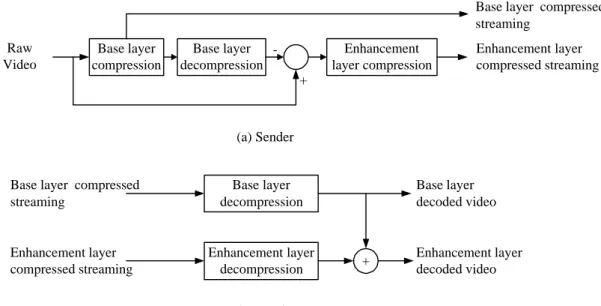
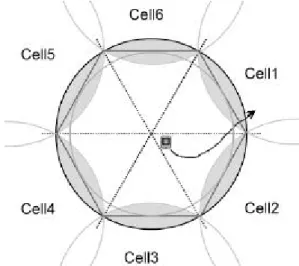
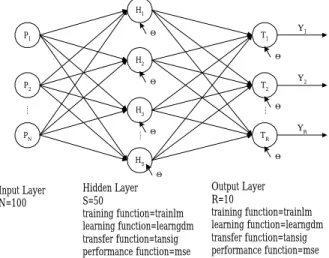
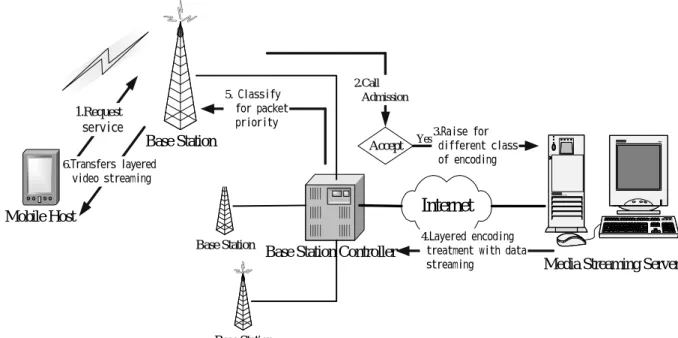
相關文件
=> Cross-curricular vocabulary is an important resource for cross-curricular reading.. => Cross-curricular vocabulary can best be taught through
Now, nearly all of the current flows through wire S since it has a much lower resistance than the light bulb. The light bulb does not glow because the current flowing through it
• to assist in the executive functions of financial resource management (such as procurement of goods and services, handling school trading operations, acceptance of donations,
another direction of world volume appears and resulting theory becomes (1+5)D Moreover, in this case, we can read the string coupling from the gauge field and this enables us to
If land resource for private housing increases, the trading price in private housing market will decrease but there may not be any effects on public housing market 54 ; if we
If necessary, you might like to guide students to read over the notes and discuss the roles and language required of a chairperson or secretary to prepare them for the activity9.
If land resource for private housing increases, the trading price in private housing market will decrease but there may not be any effects on public housing market 54 ; if
The exploration of the research can be taken as a reference that how to dispose the resource when small and medium enterprise implement management information system.. The
